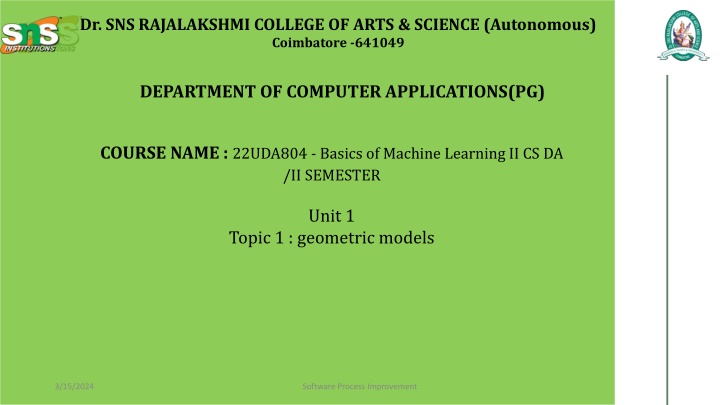
Geometric Models in Machine Learning: Understanding Linear & Non-linear Approaches
Explore the realm of geometric models in machine learning, where linear models like Linear Regression and SVM coexist with distance-based models such as KNN and K-Means Clustering. Delve into Manifold Learning techniques like PCA, t-SNE, and UMAP that handle non-linear data structures with finesse, paving the way for insightful data analysis and visualization.
Download Presentation

Please find below an Image/Link to download the presentation.
The content on the website is provided AS IS for your information and personal use only. It may not be sold, licensed, or shared on other websites without obtaining consent from the author. If you encounter any issues during the download, it is possible that the publisher has removed the file from their server.
You are allowed to download the files provided on this website for personal or commercial use, subject to the condition that they are used lawfully. All files are the property of their respective owners.
The content on the website is provided AS IS for your information and personal use only. It may not be sold, licensed, or shared on other websites without obtaining consent from the author.
E N D
Presentation Transcript
Dr. SNS RAJALAKSHMI COLLEGE OF ARTS & SCIENCE (Autonomous) Coimbatore -641049 DEPARTMENT OF COMPUTER APPLICATIONS(PG) COURSE NAME : 22UDA804 - Basics of Machine Learning II CS DA /II SEMESTER Unit 1 Topic 1 : geometric models 3/15/2024 Software Process Improvement
geometric models 1. Linear Models (Geometric Perspective) Definition: Models that assume data points can be separated using a linear decision boundary (a line in 2D, a plane in 3D, or a hyperplane in higher dimensions). Examples: Linear Regression: Fits a straight line to predict a continuous outcome. Logistic Regression: Uses a decision boundary (hyperplane) for binary classification. Support Vector Machines (SVM): Finds the optimal hyperplane that maximizes margin between classes AWS FUNDAMENTALS
geometric models Geometric Interpretation: Linear models assume data can be separated by straight lines or planes in feature space. SVM uses "support vectors" to maximize the distance between classes. AWS FUNDAMENTALS
geometric models 2. Distance-Based Models Definition: Models that classify or cluster data points based on geometric distances in feature space. Examples: K-Nearest Neighbors (KNN): Classifies a data point based on the majority class of its nearest neighbors. K-Means Clustering: Groups data points into clusters based on centroid distances. Hierarchical Clustering: Forms a tree (dendrogram) to represent nested groupings. AWS FUNDAMENTALS
geometric models Geometric Interpretation: KNN assumes similar points lie close in a high-dimensional space. K-Means minimizes the sum of squared distances between points and their cluster centers. AWS FUNDAMENTALS
geometric models 3. Manifold Learning (Non-Linear Geometric Models) Definition: Techniques that assume high-dimensional data lies on a lower-dimensional curved surface (manifold). Examples: Principal Component Analysis (PCA): Reduces dimensions by finding the directions of maximum variance. t-SNE (t-Distributed Stochastic Neighbor Embedding): Preserves local relationships in high- dimensional data. UMAP (Uniform Manifold Approximation and Projection): Captures both local and global structure. AWS FUNDAMENTALS
geometric models Geometric Interpretation: PCA projects data into a new coordinate system to minimize redundancy. t-SNE and UMAP preserve distances in a meaningful way for visualization. AWS FUNDAMENTALS
geometric models 4. Graph-Based Models Definition: Models that represent data as a network (graph) with nodes and edges. Examples: Graph Neural Networks (GNNs): Learn representations from graph-structured data. PageRank Algorithm: Determines importance of web pages using link structures. Spectral Clustering: Uses eigenvalues of graph Laplacians to cluster nodes. Geometric Interpretation: Graphs encode relationships between entities in a geometric structure. Learning involves message passing across graph edges. AWS FUNDAMENTALS
geometric models 5. Kernel Methods (Implicit Geometric Representations) Definition: Transform data into a higher-dimensional space using a kernel function. Examples: Kernel SVM: Projects data into a higher-dimensional space where a linear separator exists. Gaussian Process Regression (GPR): Models uncertainty using kernel-based covariance. Geometric Interpretation: Data that is not linearly separable can become separable in a higher-dimensional feature space. Kernels implicitly define geometric transformations. AWS FUNDAMENTALS
geometric models AWS FUNDAMENTALS
